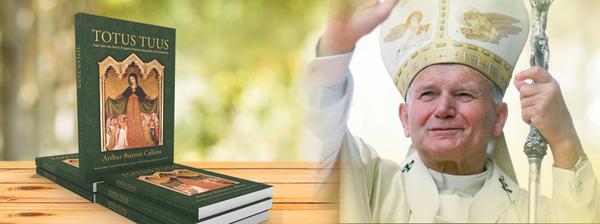
Revised Edition: Totus, Tuus: St. John Paul II's Program of Marian Consecration and Entrustment
 It gives me great joy to write a few words of introduction to this book in which Father Arthur B. Calkins examines John Paul II’s program of Marian consecration and entrustment, highlighting particularly the fact that this program takes its origin from the will of Christ and is ultimately directed to Him. Having worked closely with Father Calkins for almost three years, I have had ample opportunity to appreciate his overall theological preparation, his particular familiarity with Mariology, his careful judgment, and his fac1l'ity in expressing
It gives me great joy to write a few words of introduction to this book in which Father Arthur B. Calkins examines John Paul II’s program of Marian consecration and entrustment, highlighting particularly the fact that this program takes its origin from the will of Christ and is ultimately directed to Him. Having worked closely with Father Calkins for almost three years, I have had ample opportunity to appreciate his overall theological preparation, his particular familiarity with Mariology, his careful judgment, and his fac1l'ity in expressingcomplex matters with clarity.
Father Calkins has chosen a most important topic, one which helps us to appreciate more profoundly this characteristic note of the spirituality which is lived by so many and which has become a special hallmark of the pontificate of Pope John Paul II. One must also recognize that this spirituality of consecration or entrustment to the Mother of God is a “sign of contradiction” (cf. Lk 2:34) for not so few among our separated brothers and even those within the Church. My hope is that those who have difficulties with this practice might consider attentively its scriptural bases as they are indicated by the Holy Father and faithfully presented by Father Calkins. But for those, as well, who are already disposed in one way or another to the prospect of giving themselves entirely into the hands of Our Lady in order to belong more completely to her Divine Son, I believe that this work may prove to be of great value.
Without being exhaustive, I find Father Calkins’ treatment of Marian consecration in the spiritual journey of the Church very interesting and informative. I would single out for particular attention his handling of two important developments in the modern period. He has indicated the significant role ofthe Marian Congregations promoted since the sixteenth century by the Society of Jesus and the importance of their formula of consecration to Our Lady (even if one might regret the recent modification of their title), and he has established the fact very clearly that by the formula “Marian consecration” Saint Louis-Marie Grignion de Montfort always understood the consecration of oneself to Christ through the hands of Mary.
What Father Calkins corroborates in de Montfort and, indeed, in all the other major proponents of entrustment to Mary is the right understanding of “through Mary”. For instance, when de Montfort speaks of Mary’s mediation or of our going to Christ through her, he is not setting up Our Lady as a barrier which must be overcome before reaching Our Lord, nor as a hurdle which must be surmounted before arriving at our goal, nor of any chronological process. Rather, according to de Montfort, with Mary we reach Jesus more quickly, love Him more tenderly, and serve Him more faithfully. The “through Mary” brings about a more intensely immediate union with the Eternal and Incarnate Wisdom. Mary does not stand in the way. Far from it, she is the “mysterious millieu”, the atmosphere in which our union with God is readily facilitated.
In this "Totus Tuus," Msgr. Arthur Burton Calkins’ study of Pope St. John Paul II’s program of Marian entrustment and consecration, examines issues of Marian consecration both in the history and magisterial teaching of the Church. Msgr. Calkins discusses such important issues as the role of Mary in the relationship between God and his people, the validity of “consecration” to Mary, the Christ-centeredness of this practice, and why the Pope found entrustment to Mary so vital in the life of individuals, peoples and the Church— more than ever in our own times. Herein you will find a thorough examination of the scriptural and theological bases of Marian consecration as taught by this great Pontiff who, more than any of his predecessors in the Chair of Peter, so eloquently shed light on this precious Marian patrimony bequeathed by Christ to the Church.
